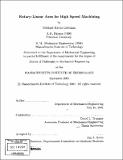Rotary-linear axes for high speed machining
Author(s)
Liebman, Michael Kevin, 1974-
DownloadFull printable version (25.75Mb)
Other Contributors
Massachusetts Institute of Technology. Dept. of Mechanical Engineering.
Advisor
David L. Trumper.
Terms of use
Metadata
Show full item recordAbstract
This thesis presents the design, analysis, fabrication, and control of a rotary-linear axis; this axis is a key subsystem for high speed, 5-axis machine tools intended for fabricating centimeter-scale parts. The rotary-linear axis is a cylinder driven independently in rotation and translation. This hybridization minimizes machine inertias and thereby maximizes accelerations allowing for the production of parts with complex surfaces rapidly and accurately. Such parts might include dental restorations, molds, dies, and turbine blades. The hybrid rotary and linear motion provides special challenges for precision actuation and sensing. Our prototype rotary-linear axis consists of a central shaft, 3/4 inch (1.91 cm) in diameter and 15 inches (38.10 cm) long, supported by two cylindrical air bearings. The axis has one inch (2.54 cm) of linear travel and unlimited rotary travel. Two frameless permanent magnet motors respectively provide up to 41 N continuous force and 0.45 N-m continuous torque. The rotary motor is composed of commercially available parts; the tubular linear motor is completely custom-built. The prototype axis achieves a linear acceleration of 3 g's and a rotary acceleration of 1,300 rad/s2. With higher power current amplifiers and reduced sensor inertia, we predict the axis could attain peak accelerations of 12 g's and 17,500 rad/s2 at low duty cycles. This thesis also examines several concepts for developing a precision rotary-linear sensor that can tolerate axial translation. Our prototype rotary sensor uses two laser interferometers to measure the orientation of a slightly tilted mirror attached to the shaft. A third interferometer measures shaft translation. The rotary axis has a control bandwidth of 40 Hz; the linear axis has a bandwidth of 70 Hz. The rotary-linear axis has 2.5 nm rms linear positioning noise and 3.1 prad rms rotary positioning noise. This thesis presents one novel 5-axis machine topology which uses two rotary-linear axes. The first axis rotates and translates the part. The second axis carries the cutting tool and provides high speed spindle rotation as well as infeed along the axis of rotation. For use as a spindle, precision rotary sensing is not required, and a sensorless control scheme based on motor currents and voltages can be used.
Description
Thesis (Ph. D.)--Massachusetts Institute of Technology, Dept. of Mechanical Engineering, 2001. Includes bibliographical references (p. 353-358).
Date issued
2001Department
Massachusetts Institute of Technology. Department of Mechanical EngineeringPublisher
Massachusetts Institute of Technology
Keywords
Mechanical Engineering.